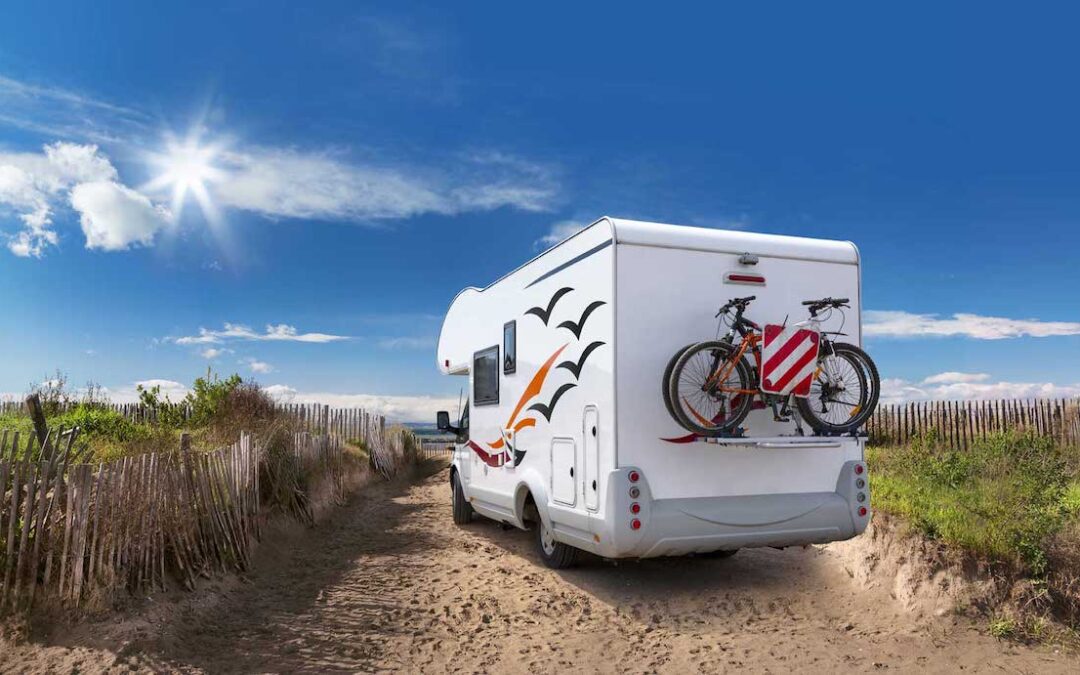Summer is here, which means the seasonal surge of vacations and road trips is underway. It’s an exciting time for the RVers who look forward to the laid-back, happy-go-lucky vibe of the warmer months all year long.
While the easy feeling of summer is unquestionably appealing, it’s important for RVers to keep a few things in mind in order to keep their travels comfortable and safe.
If you’re gearing up for your own summertime RV excursion, here are a few tips to help your adventure be successful:
Take Care of Your RV Awning
When it comes to summer RVing, a large part of the fun is immersing your RV in beautiful scenery and setting up a leisurely, shaded area underneath your RV awning. Because they are such an integral part of the RV experience, it’s important to keep yours in good shape so that it can provide years of heat relief.
Awnings are made to protect you from the sun, and high quality ones are made to withstand intense sunlight. That being said, over-exposure to intense rays can cause the awning fabric to fade and eventually wear down.
To avoid this, RV awning covers and sealants are available to help keep your awning protected from the elements. If your fabric is looking tattered and torn but the hardware is otherwise in good shape, you can always look into RV awning replacement fabric.
Additionally, summer weather can often be unpredictable with calm weather quickly turning into harsh storms. Hail can damage your awning’s hardware, whereas too much rain can pool into the canopy, causing the fabric to become warped and stretched out.
To avoid any issues, it’s best to keep your awning retracted when you are not at the campsite, and it’s also helpful to stay up-to-date on the expected forecast so that you can retract your awning before a storm hits.
Remember to try and avoid retracting your awning when wet to avoid mildew and mold. If you absolutely need to roll up your awning when it’s damp, unroll it, and let it air dry as soon as possible.
Minimize Heat Inside of Your RV
While modern rigs come with functioning air conditioning, there are ways to keep your RV cool in the event you won’t have access to AC, you don’t have a functioning unit, or you want to minimize your AC use as much as possible.
To help keep heat out of the RV, here are a few tips to try out:
-
Avoid cooking inside during the hottest times of the day
At times when it’s blistering inside of your RV, using the RV’s stove will only add to the problem. At times like this, eating cold-based meals like sandwiches or cooking on an outdoor grill will spare your RV from harboring more heat.
-
Use insulation to prevent heat transfer
Many RVers use a reflective type of insulation, a common brand is Reflectix, and put this in the windows. It reflects sunlight away from the RV, helping to keep the inside temperature down.
-
Park in the shade
Before making an RV park reservation, try to find a spot that provides ample shade. By parking the side of your RV that contains the most windows in the shade, you can help keep the heat out.
-
Utilize RV window shades
These are shades made specifically for RV windows to block sunlight and keep your RV cool.
Monitor Mechanical Health
Heat can be hard on your RV. It can cause the tire pressure to expand, the rubber on the tires to weaken, and the engine to overheat.
Before taking your RV on a big summer trek, make sure you perform any necessary repairs and maintenance upkeep. If you don’t know how to give your rig a thorough check up, it’s more than worth it to take it in for a professional, well-rounded inspection.
Be Mindful With Your RV Destinations
Before fully committing to a destination, conduct some preliminary research of where you plan to travel.
For starters, consider what type of experience you want, and think about what your main motivation is for travel. Are you mainly interested in seeking out popular activities and significant landmarks, or are you trying to bask in some much-needed solitude?
If you choose a destination that’s a top-tourist destination, you’ll most likely be looking at crowded or fully-booked RV parks as well as long lines and crowds for main attractions and scenic sites.
Additionally, consider what the actual location presents in regards to weather and wildlife. For example, if you’re heading to an area with rattlesnakes but don’t have any snakes where you’re coming from, learning how to prevent an issue as well as how to handle an emergency is a good idea.
Remember, knowing what to expect ahead of time and taking the appropriate safety measures will help your experience go smooth and hassle-free.
Always Keep an Emergency Kit With You While RVing
Before any trip, it’s important to be ready for the unexpected. One of the best ways to do this is to never embark on an RV trip without bringing an emergency kit with you.
Helpful items to include are:
- Flashlights with extra batteries
- Spare tire/tire repair kit
- Jack
- Tool set
- Jumper cables
- Tow ropes
- Oil and coolant fluid
- Kitty litter for traction
- Shovel
- First aid kit
- Extra cell phone charger/car charger
- Weather-alert radio
- Satellite messenger (for making emergency calls when there is no cell phone service)
- Flares
- Space blankets
- Extra layers/clothes
- Sunscreen
- Drinking water
- Non-perishable food
- Spare medication
- Fire extinguisher
- Multi-use knife
- Electrical/duct tape
- Tie downs
Be Prepared for Weather Changes
Summer storms are known for coming on spontaneously, and by driving through different landscapes and terrain, you may experience drastic drops or rises in temperature.
Here are a few ways to be ready for what Mother Nature decides to throw your way:
- Keep extra layers and clothing types on hand
You want to be able to put on a jacket and tennis shoes if it gets chilly as well as slip into a t-shirt and flip flops when it heats up.
- Make sure your windshield wipers work
Sudden rain can come pouring down, so be sure your wipers are in solid shape.
- Ensure your heat and AC are in working order
In order to stay comfortable in extreme temperatures, you’ll need these to function.
- Consider investing in a weather-alert radio
These will give you updates on any big weather changes, and they work even when you’re in areas with no service. This will help you plan your travels accordingly as well as give you warning of any inclement weather approaching in the area.
Take Action Against Bugs
Pesky insects can ruin any RV trip, and thinking about this in advance can save you a world of frustration. While a few run-ins with bugs are an inevitable part of enjoying the outdoors and the RV lifestyle, there are steps you can take to prevent them from invading your rig as well as pestering you outside.
To learn how to keep your interaction with any pests to a low, read our article on RV bug prevention here.
Closing Up
Hopefully this information helps shed some light on how to plan smooth and easy summertime travels. If you take the time to iron out the details, your next RV adventure should be nothing short of a memorable and refreshing experience.
Happy trails!
Stay Cool This Summer With Carefree of Colorado’s RV Awnings and Accessories
Summer RVing offers boundless opportunities for much-needed relaxation and exciting recreational activities, but the sweltering heat can put a damper on even the most ideal vacations.
To help you stay cool and comfortable this summer, Carefree of Colorado has an extensive line of RV awnings and accessories.
Browse our RV products today to find what you need to beat the heat!

